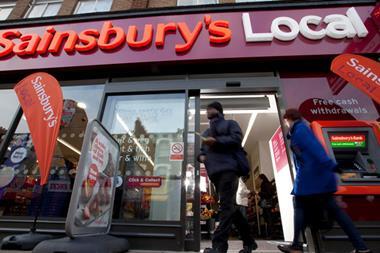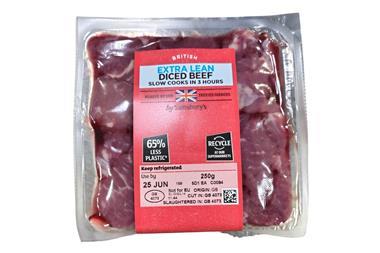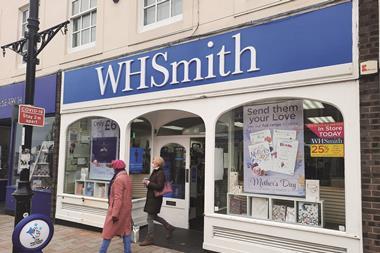Few will have realised that when Sainsbury opened its upmarket Market at Bluebird on the Kings Road in March, some of the format was borrowed from its wholly owned US subsidiary Shaw's.
"There are similarities some of the product displays were made to look like Shaw's," says president and chief executive officer Paul Gannon. "It's one of the things we look for truly innovative presentation. And some of the things that Sainsbury has done with its produce have come from us."
Gannon has every right to feel proud. The once small family-owned company that focused purely on price in the early 1990s has become a 185-store chain that generates year-on-year sales growth of 10% and profits of 26% exceeding its 20% target over the past five years. And its recent success is due as much to his strategic nous as to the financial clout of Shaw's UK parent.
In his first UK interview since taking over as chief executive last October, Gannon reveals why Shaw's is now venturing into ethnic foods, what the latest developments are in the dispute with unions over workers' rights, and the safety of GM products and how it has benefited from the Sainsbury connection.
The 50-year-old is over on one of his regular flying visits to Sainsbury's business centre in Holborn. "I visit every month, 13 months a year," he jokes. Sainsbury has just announced its annual results and Gannon sits on the main board, but he is also here to report on Shaw's new 40,000 sq ft flagship store at the Prudential Centre in Boston which opened last month.
The store replaces one that was half its size and it now focuses on delivering what its well-heeled clientele wants in a spacious deli-style environment. So there is an emphasis on fresh produce, an open bakery, a large seafood counter and a wine department that stocks more than 1,000 wines and 300 microbrews. There are also "10 game meats and 400 cheeses flown in from France and Italy every week", boasts Gannon.
"Our aim is to be best in the marketplace," he says. "This is a unique site for New England in that it has 70% foot traffic typically 98% is car traffic and is in a highly affluent area where the average size of a household is one person."
It might sound like a gamble but Gannon says early indications are good in contrast to the muted feedback that has greeted Sainsbury at Bluebird. The US store has had 45,000 to 50,000 customers a week and that figure should increase in the coming weeks, he says.
It is a far cry from the teashop that a young man from Vermont named George C Shaw opened in Portland, Maine, in the late 1850s. Popular for its selection of fresh foods and groceries as well as teas, the company was taken over in 1919 by local chain Brockton Public Market (BPM) and continued as a subsidiary, expanding to northern Massachusetts while BPM remained south.
In 1978, the BPM stores were rebadged as Shaw's Supermarkets Inc and in 1987 Sainsbury, which had had a 21% stake since 1983, acquired the controlling interest.
Gannon has been with the company since 1990. He joined as president of information technology and rose to become president last March, then to chief executive in October. It was his work developing new formats that caught the eye of Sainsbury group chief executive Sir Peter Davis. "Format is what really fires me up," confesses Gannon. "It's fun trying to work out exactly what customers want, but it is not as easy as it sounds."
New formats are essential to compete with the region's biggest food store chain Ahold's Stop'n' Shop and the all-dominant Wal-Mart, argues Gannon. "We really have to differentiate our offer. It's difficult to compete on price so we have to sharpen our customer service, targeted promotions and format."
Over the next 12 months, Shaw's plans to roll out further upmarket stores and is also adding two other new formats to the mix. Its first "core plus store", which includes a large non-food offer, opened last weekend in South Burlington, Vermont, and a third of all future new stores are expected to follow the same 50-55,000 sq ft format.
And a fortnight ago Shaw's launched its first "neighbourhood store" in Providence, Rhode Island, designed to cater to the tastes of the local community, of which half are Hispanic and a third Italian.
The store decor is very different to a traditional Shaw's. It has brighter lights and more vivid colours, and sells more bulk produce. Of the 40,000 lines it will feature, 5,000 will be kosher, 3,000 Italian, and there will be a number of speciality lines.
Gannon explains: "Market research showed bright colours are popular even with things like cakes. If you have one plainly decorated and one with multicoloured icing, it is the latter that sells well."
Gannon is quick to acknowledge that Shaw's would not have been able to implement such an ambitious strategy without the support and strategic knowhow of Sainsbury. "We look at things broadly and Sainsbury drills down more deeply," says Gannon. This year Shaw's has concluded 40 online negotiations through GNX auctions and done a lot of work on its own label brands with help from Sainsbury.
"Another synergy has been figuring out returns on a micro level and fine-tuning the variety of products we stock in the US the big players are only just beginning to do it, but it's more commonplace in the UK," he says.
Over the past four years, Sainsbury's financial clout has also been deployed. It has backed several acquisitions the biggest being Star Markets in 1999. This year, Shaw's plans to add 14% of new floor space to its portfolio through organic growth and convert some of the stores it acquired last year.
"Future growth is likely to be more organic," says Gannon. "But we will continue to look for more opportunities in the market. We are focusing on tailoring our stores to the communities they are in and we will continue to evolve the formats."
This is something of a moot point as last year the chain hit the headlines when union members went on strike over workers' rights and the sale of GM products. The situation has now quietened down, but it was never a problem, says Gannon: "It was a non-event. The employees were dissatisfied with the union and it was trying to recoup membership."
For Gannon there are more pressing things to worry about. He says. "The big issue is the economy. It's weak and that creates a challenge to sales. Costs are escalating while Wal-Mart supercentres have hit retailers across the country they're tough competition."
{{ANALYSIS }}
"There are similarities some of the product displays were made to look like Shaw's," says president and chief executive officer Paul Gannon. "It's one of the things we look for truly innovative presentation. And some of the things that Sainsbury has done with its produce have come from us."
Gannon has every right to feel proud. The once small family-owned company that focused purely on price in the early 1990s has become a 185-store chain that generates year-on-year sales growth of 10% and profits of 26% exceeding its 20% target over the past five years. And its recent success is due as much to his strategic nous as to the financial clout of Shaw's UK parent.
In his first UK interview since taking over as chief executive last October, Gannon reveals why Shaw's is now venturing into ethnic foods, what the latest developments are in the dispute with unions over workers' rights, and the safety of GM products and how it has benefited from the Sainsbury connection.
The 50-year-old is over on one of his regular flying visits to Sainsbury's business centre in Holborn. "I visit every month, 13 months a year," he jokes. Sainsbury has just announced its annual results and Gannon sits on the main board, but he is also here to report on Shaw's new 40,000 sq ft flagship store at the Prudential Centre in Boston which opened last month.
The store replaces one that was half its size and it now focuses on delivering what its well-heeled clientele wants in a spacious deli-style environment. So there is an emphasis on fresh produce, an open bakery, a large seafood counter and a wine department that stocks more than 1,000 wines and 300 microbrews. There are also "10 game meats and 400 cheeses flown in from France and Italy every week", boasts Gannon.
"Our aim is to be best in the marketplace," he says. "This is a unique site for New England in that it has 70% foot traffic typically 98% is car traffic and is in a highly affluent area where the average size of a household is one person."
It might sound like a gamble but Gannon says early indications are good in contrast to the muted feedback that has greeted Sainsbury at Bluebird. The US store has had 45,000 to 50,000 customers a week and that figure should increase in the coming weeks, he says.
It is a far cry from the teashop that a young man from Vermont named George C Shaw opened in Portland, Maine, in the late 1850s. Popular for its selection of fresh foods and groceries as well as teas, the company was taken over in 1919 by local chain Brockton Public Market (BPM) and continued as a subsidiary, expanding to northern Massachusetts while BPM remained south.
In 1978, the BPM stores were rebadged as Shaw's Supermarkets Inc and in 1987 Sainsbury, which had had a 21% stake since 1983, acquired the controlling interest.
Gannon has been with the company since 1990. He joined as president of information technology and rose to become president last March, then to chief executive in October. It was his work developing new formats that caught the eye of Sainsbury group chief executive Sir Peter Davis. "Format is what really fires me up," confesses Gannon. "It's fun trying to work out exactly what customers want, but it is not as easy as it sounds."
New formats are essential to compete with the region's biggest food store chain Ahold's Stop'n' Shop and the all-dominant Wal-Mart, argues Gannon. "We really have to differentiate our offer. It's difficult to compete on price so we have to sharpen our customer service, targeted promotions and format."
Over the next 12 months, Shaw's plans to roll out further upmarket stores and is also adding two other new formats to the mix. Its first "core plus store", which includes a large non-food offer, opened last weekend in South Burlington, Vermont, and a third of all future new stores are expected to follow the same 50-55,000 sq ft format.
And a fortnight ago Shaw's launched its first "neighbourhood store" in Providence, Rhode Island, designed to cater to the tastes of the local community, of which half are Hispanic and a third Italian.
The store decor is very different to a traditional Shaw's. It has brighter lights and more vivid colours, and sells more bulk produce. Of the 40,000 lines it will feature, 5,000 will be kosher, 3,000 Italian, and there will be a number of speciality lines.
Gannon explains: "Market research showed bright colours are popular even with things like cakes. If you have one plainly decorated and one with multicoloured icing, it is the latter that sells well."
Gannon is quick to acknowledge that Shaw's would not have been able to implement such an ambitious strategy without the support and strategic knowhow of Sainsbury. "We look at things broadly and Sainsbury drills down more deeply," says Gannon. This year Shaw's has concluded 40 online negotiations through GNX auctions and done a lot of work on its own label brands with help from Sainsbury.
"Another synergy has been figuring out returns on a micro level and fine-tuning the variety of products we stock in the US the big players are only just beginning to do it, but it's more commonplace in the UK," he says.
Over the past four years, Sainsbury's financial clout has also been deployed. It has backed several acquisitions the biggest being Star Markets in 1999. This year, Shaw's plans to add 14% of new floor space to its portfolio through organic growth and convert some of the stores it acquired last year.
"Future growth is likely to be more organic," says Gannon. "But we will continue to look for more opportunities in the market. We are focusing on tailoring our stores to the communities they are in and we will continue to evolve the formats."
This is something of a moot point as last year the chain hit the headlines when union members went on strike over workers' rights and the sale of GM products. The situation has now quietened down, but it was never a problem, says Gannon: "It was a non-event. The employees were dissatisfied with the union and it was trying to recoup membership."
For Gannon there are more pressing things to worry about. He says. "The big issue is the economy. It's weak and that creates a challenge to sales. Costs are escalating while Wal-Mart supercentres have hit retailers across the country they're tough competition."
{{ANALYSIS }}


















No comments yet